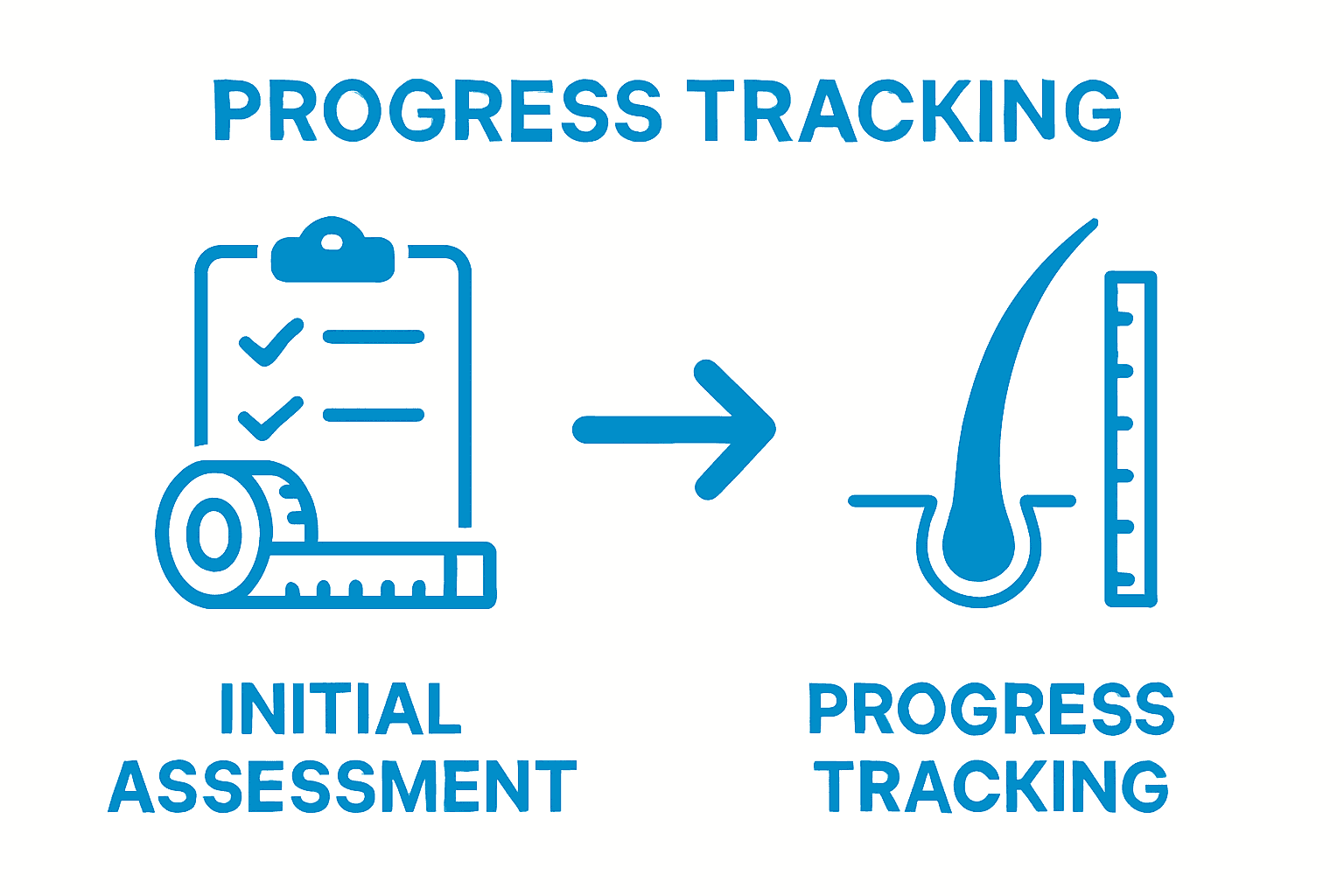Blog
Learning Materials
Grow Hair Longer and Thicker: Your 2025 Guide
Updated: September 8, 2025

Growing hair that is longer and thicker can feel impossible when breakage seems constant and progress is painfully slow. Yet research shows chronic stress, poor diet, and even lack of sleep can disrupt hair growth cycles more than you might expect. The real surprise is how simple changes like measuring your hair, tracking your habits, and making the right nutrition tweaks can jumpstart noticeable results.
Table of Contents
- Step 1: Assess Your Hair Health And Growth Goals
- Step 2: Choose A Nutrient-Rich Diet For Hair Growth
- Step 3: Implement A Consistent Hair Care Routine
- Step 4: Utilize Effective Hair Growth Treatments
- Step 5: Monitor Progress And Adjust Your Strategy
Quick Summary
| Key Point | Explanation |
|---|---|
| 1. Assess Your Hair Health | Conduct a detailed examination of your hair and scalp to understand current conditions and growth barriers. |
| 2. Eat a Nutrient-Rich Diet | Focus on high protein, biotin-rich, and micronutrient foods to support hair strength and growth. |
| 3. Establish a Consistent Hair Care Routine | Tailor your washing and conditioning practices to your hair type for optimal health and minimal damage. |
| 4. Use Effective Hair Growth Treatments | Implement topical treatments and consider laser therapy or supplements for supportive growth stimulation. |
| 5. Monitor and Adjust Your Strategy | Keep a detailed journal of your progress and be willing to adapt your approach based on results and expert advice. |
Step 1: Assess Your Hair Health and Growth Goals
Successfully growing longer and thicker hair begins with a comprehensive understanding of your current hair health and establishing clear, personalized growth objectives. This initial assessment provides the foundation for your entire hair transformation journey, helping you create a targeted strategy that addresses your unique needs.
Starting your hair growth journey requires honest self-evaluation and strategic planning. Begin by performing a detailed scalp and hair examination in good lighting, preferably near a mirror with natural daylight. Look closely at your hair's current condition, examining factors like strand thickness, scalp health, breakage points, and overall hair density. Pay special attention to areas showing thinning or reduced growth, as these regions will need focused intervention.
Learn more about your specific hair growth patterns to understand the nuanced aspects of your individual hair profile. Tracking your baseline measurements is crucial. Use a soft measuring tape to record your current hair length at multiple points around your head, noting any asymmetry or uneven growth patterns. Document these initial measurements in a dedicated notebook or digital tracking app, which will serve as your reference point for monitoring progress.
Your assessment should also include a comprehensive review of potential growth barriers. Evaluate lifestyle factors that might impede hair development, such as stress levels, nutritional intake, sleep quality, and hormone balance. Chronic stress, poor diet, and inadequate sleep can significantly disrupt hair growth cycles, making them critical elements to address early in your journey.
Key verification indicators that you've completed this step successfully include:
- Detailed hair and scalp condition documentation
- Baseline length measurements recorded
- Identified potential growth barriers
- Initial growth goals clearly articulated
Remember that this assessment is not about perfection but about creating an honest, realistic roadmap for your hair growth strategy. Each insight you gather brings you closer to understanding your hair's unique characteristics and potential.
Step 2: Choose a Nutrient-Rich Diet for Hair Growth
Transforming your hair from the inside out requires a strategic nutritional approach that provides the essential building blocks for robust, healthy hair growth. Your diet plays a fundamental role in determining hair strength, thickness, and overall quality, making food selection a critical component of your hair growth journey.
Focus on creating a balanced nutritional profile that emphasizes protein-rich foods, which form the core structural foundation of hair. Lean proteins like chicken, fish, eggs, and legumes are crucial for keratin production, the primary protein responsible for hair structure. Incorporate foods high in biotin, such as almonds, sweet potatoes, and eggs, which support metabolic processes directly linked to hair health. Learn more about nutrition strategies for hair growth to deepen your understanding of targeted dietary interventions.
Beyond protein, micronutrients play a significant role in hair development. Iron-rich foods like spinach, lentils, and lean red meats help prevent hair loss by supporting oxygen transportation to hair follicles. Omega-3 fatty acids found in salmon, chia seeds, and walnuts contribute to scalp health and reduce inflammation that can impede hair growth. Zinc, present in pumpkin seeds, beef, and shellfish, supports protein synthesis and cellular repair mechanisms essential for hair regeneration.
Hydration is another often overlooked aspect of nutritional hair care. Drinking adequate water ensures that nutrients are efficiently transported throughout your body, supporting metabolic processes that contribute to hair growth. Aim for at least eight glasses of water daily, adjusting based on your activity level and climate.
Key dietary verification indicators include:
- Consistent intake of protein-rich foods
- Daily consumption of diverse micronutrient sources
- Minimum of 8 glasses of water per day
- Reduction of processed and sugary foods
- Noticeable improvements in hair texture within 8-12 weeks
Remember that dietary changes are a long-term commitment. Patience and consistency are your most powerful tools in achieving the lush, vibrant hair you desire. Your nutritional strategy is not just about what you eat, but about creating a sustainable approach to holistic hair health.

Step 3: Implement a Consistent Hair Care Routine
Developing a strategic and consistent hair care routine is the cornerstone of achieving longer, thicker hair. This step transforms your previous nutritional efforts into tangible hair growth results by providing the external care and protection necessary for optimal hair development.
Selecting the right hair washing frequency is critical and depends entirely on your unique hair type and scalp condition. Those with oily hair might require washing every other day, while individuals with dry or textured hair could benefit from less frequent washing, perhaps 2-3 times per week. Explore our comprehensive hair routine strategies to customize your approach precisely.
Invest in high-quality, sulfate-free shampoos and conditioners that match your specific hair type. When washing, focus shampoo application on your scalp, gently massaging to stimulate blood circulation and remove buildup. Use lukewarm water, as extremely hot temperatures can damage hair cuticles and strip natural oils. After shampooing, apply conditioner primarily to hair ends, working upward to prevent weighing down hair roots. This technique helps prevent breakage and maintains moisture balance.
Brushing technique plays a significant role in hair health. Use a wide-toothed comb or soft-bristled brush to detangle hair gently, starting from the ends and working upward to minimize stress on hair strands. Avoid aggressive brushing, especially when hair is wet, as this is when strands are most vulnerable to breakage. Consider silk or satin pillowcases to reduce friction during sleep, which can cause unnecessary hair damage.
Protecting your hair from environmental stressors is equally important. Limit heat styling, and when necessary, always use a heat protectant spray. Minimize exposure to direct sunlight, chlorine, and saltwater, which can cause significant hair damage. Consider wearing protective styles or using lightweight hair oils that provide a barrier against environmental stress.
Key verification indicators for your hair care routine include:
- Consistent, tailored washing schedule
- Reduced hair breakage and split ends
- Improved hair texture and shine
- Less scalp irritation
- Noticeable reduction in hair fall during washing or brushing
Remember that establishing a hair care routine is a personal journey. What works perfectly for someone else might require slight adjustments for your unique hair characteristics. Patience, observation, and willingness to adapt are your greatest allies in achieving the lush, healthy hair you desire.
Step 4: Utilize Effective Hair Growth Treatments
Selecting and implementing targeted hair growth treatments represents a critical turning point in your journey toward longer, thicker hair. This step transforms your previous foundational work into actionable strategies that directly stimulate and support hair follicle health and growth potential.
Topical treatments form the first line of proactive hair restoration, with minoxidil emerging as a scientifically validated solution for both men and women. When applying topical treatments, consistency is paramount. Gently massage the product into your scalp, ensuring even distribution and maximum absorption. Explore our advanced hair treatment solutions to understand the nuanced approaches available for your specific hair needs.
Consider incorporating low-level laser therapy (LLLT) as a non-invasive complementary treatment. These specialized devices emit specific wavelengths of light that stimulate cellular activity within hair follicles, potentially increasing blood flow and encouraging hair growth. Home-use laser caps or professional in-office treatments offer flexible options for integrating this technology into your hair restoration strategy.
Natural supplements can provide additional support for your hair growth efforts. Biotin, zinc, and marine protein complexes have demonstrated potential in supporting hair follicle strength and promoting healthier growth cycles. However, always consult with a healthcare professional before starting any new supplement regimen to ensure compatibility with your individual health profile.
For those experiencing more advanced hair thinning, professional treatments like platelet-rich plasma (PRP) injections or concentrated growth factor therapies might offer more targeted intervention. These treatments leverage your body's natural healing mechanisms to stimulate dormant hair follicles and potentially reverse miniaturization processes.
Key verification indicators for your hair growth treatment approach include:
- Consistent application of chosen treatments
- Reduced hair shedding within 3-6 months
- Visible improvements in hair density
- Enhanced scalp health and reduced inflammation
- Increased hair shaft diameter
Remember that hair growth is a complex, individualized process. What works remarkably well for one person might yield different results for another. Patience, careful observation, and a willingness to adjust your approach are essential. Track your progress meticulously, take periodic photographs, and be prepared to modify your treatment strategy based on your body's unique response.

Step 5: Monitor Progress and Adjust Your Strategy
Successful hair growth is not a linear journey but a dynamic process requiring consistent observation, reflection, and strategic adaptation. This critical step transforms your previous efforts into a responsive, personalized approach that evolves with your unique hair growth characteristics.
Documenting your hair growth journey becomes your most powerful analytical tool. Establish a comprehensive tracking system that goes beyond simple measurements. Discover advanced progress tracking methods to refine your approach systematically. Invest in high-quality photography equipment or use smartphone cameras with consistent lighting to capture monthly progress photos. Position yourself in the same location, with identical lighting and camera angle, to ensure accurate visual comparisons.
Quantitative tracking requires more than visual assessment. Implement a detailed hair journal documenting critical metrics such as hair length, thickness, scalp condition, and overall hair health. Record your dietary intake, stress levels, sleep quality, and any treatment modifications. This holistic approach helps identify correlations between lifestyle factors and hair growth performance, enabling more precise strategic adjustments.
Regular professional consultations provide an objective perspective on your hair growth trajectory. Schedule quarterly appointments with trichologists or dermatology specialists who can perform microscopic scalp analyses, evaluate treatment efficacy, and recommend personalized interventions. These expert assessments can reveal subtle changes or potential issues that might not be immediately apparent through self-monitoring.
Flexibility is paramount in your hair growth strategy. Be prepared to modify your approach based on empirical evidence and professional guidance. If current treatments show minimal results after six months, consider alternative approaches or combination therapies. Some individuals might require more aggressive interventions, while others benefit from subtle, incremental changes.
Key verification indicators for your monitoring and adjustment process include:
- Consistent monthly progress documentation
- Detailed hair growth journal with comprehensive metrics
- Professional consultation records
- Measurable improvements in hair density and length
- Adaptable treatment strategy based on observed results
Remember that hair growth is a highly individualized experience. What works perfectly for one person might require significant modifications for another. Patience, meticulous observation, and a willingness to adapt are your greatest assets in achieving the robust, healthy hair you desire. Your journey is unique, and your strategy should reflect that individuality.
Below is a checklist table summarizing the key verification indicators for each main step in your hair growth journey, making it easy to track your progress.
| Step | Verification Indicators |
|---|---|
| Assess Hair Health | Detailed documentation, baseline length, growth barriers identified, goals articulated |
| Nutrient-Rich Diet | Consistent protein intake, diverse micronutrients, 8+ glasses water daily, reduced processed foods, hair texture improved |
| Hair Care Routine | Tailored washing schedule, reduced breakage and split ends, improved texture and shine, less scalp irritation, less hair fall |
| Growth Treatments | Consistent usage, less hair shedding in 3-6 months, improved density, better scalp health, increased hair shaft diameter |
| Progress Tracking | Monthly documentation, detailed journal, professional records, measurable gains, adaptable strategy |
Take Control of Your Hair Growth Success with AI-Powered Guidance
If you are struggling to achieve longer, thicker hair despite following every step from your assessment to tracking progress, you are not alone. Many readers face the same frustrations: inconsistent results, uncertainty about which treatments work best, and disappointment from not seeing expected improvements. Trying to navigate complex information and address issues like hair thinning, breakage, or slow growth can feel overwhelming. It is time to remove the guesswork from your routine and discover tools that adapt to your unique hair profile.

Imagine seeing tailored recommendations built from an advanced AI-based hair health analysis. With MyHair.ai, you receive personalized insights, growth projections, and product suggestions driven by your individual scan data. Our platform tracks your progress over time and helps you adjust strategies for real results. Do not just hope for healthier hair. Visit MyHair.ai now to access your own custom assessment and start your transformation with proven, science-backed solutions. Get the answers and the progress you deserve. Start today and make every step count toward stronger, fuller hair.
Frequently Asked Questions
How can I assess my hair health before starting a growth journey?
Begin by examining your hair and scalp in good lighting. Look for signs of breakage, scalp health, and hair density. Document your current hair length and any thinning areas to establish a baseline for your assessment.
What dietary changes can support hair growth?
Incorporate a nutrient-rich diet focused on protein, biotin, iron, and omega-3 fatty acids. Foods like fish, eggs, nuts, and leafy greens are beneficial. Also, stay hydrated by drinking adequate water daily to support overall hair health.
How do I create an effective hair care routine for growth?
Develop a consistent hair care routine that matches your hair type. This includes determining your optimal washing frequency, choosing high-quality products, gentle detangling methods, and protecting your hair from environmental stressors.
What are some effective treatments to stimulate hair growth?
Topical treatments like minoxidil and low-level laser therapy can effectively stimulate hair follicles. Additionally, natural supplements like biotin and zinc may support follicle strength. Always consult a healthcare professional before starting new treatments.